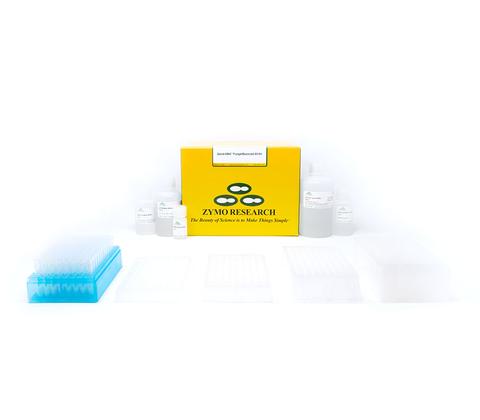
Highlights
- Boost Detection: Included BashingBeads ensure complete lysis of tough-to-lyse samples.
- Ultra-Pure: Ready for qPCR, Next-Gen Sequencing, arrays, etc.
- Simple: Fastest high-throughput workflow (= 40 minutes).
Description
The Quick-DNA Fungal/Bacterial 96 Kit is designed for the simple and rapid isolation of DNA from tough-to-lyse fungi, including A. fumigatus, C. albicans, N. crassa, S. cerevisiae, S. pombe, as well as Gram (+/-) bacteria, algae, and protozoa. The procedure is easy and can be completed in minutes: fungal and/or bacterial samples are rapidly and efficiently lysed with our state of the art, ultra-high density BashingBeads. Zymo-Spin column technology is then used to isolate the DNA that is ideal for downstream molecular-based applications including PCR, array, etc.
Technical Specifications
| Applicable For | All sensitive downstream applications such as qPCR and Next-Generation Sequencing. |
|---|---|
| Elution Volume | = 25 µl |
| Equipment | Centrifuge with microplate carriers, 96-well plate/block disruptor or pulverizer. |
| Processing Time | = 40 minutes |
| Processing Volume | =20 mg (wet weight) fungi or bacteria, 2×108 bacterial cells, 2×107 yeast cells, or 2×107 mammalian cells |
| Purity | Typical A260/A280 & A260/A230 = 1.8 |
| Sample Source | Fungal and bacterial cell cultures, spores, pollen, nematodes, as well as other microorganisms can also be sampled. |
| Size Range | Capable of recovering genomic DNA sized fragments from up to and above 40 kb. Typical fragment sizes range from 25 kb – 35 kb. If present, parasitic and viral DNA will also be recovered. |
| Type | Total DNA |
| Yield | = 5 µg total DNA |
Product FAQ
Q1: My lysate seems viscous. What is causing this to happen? How can I fix this?
A viscous sample can indicate incomplete sample lysis. Try using less of your sample and optimize bead beating conditions (duration, speed, time) to ensure samples are thoroughly lysed. After bead beating, pellet the cell debris before moving on. Adding more Genomic Lysis buffer to the lysate can help dilute and deproteinate the sample, making the sample less viscous and more suitable for DNA recovery.
Q2: Is it necessary to add beta-mercaptoethanol? Can this step be substituted or omitted?
Addition of beta-mercaptoethanol is recommended to enhance sample lysis, but can be substituted with dithiothreitol (DTT, final concentration of 10 mM). However, if bead beating is optimized and lysis is efficient, the addition of BME is not necessary and can be omitted.
Q3: When can an RNase A treatment be implemented in the protocol?
No additional RNase A treatment is required when processing samples within kit capacity. The selective chemistry allows for binding of double stranded DNA to the column and for RNA to flow through.
Citations
Kit Components
| Cat # | Name | Size |
|---|---|---|
| S6002-96-3 | ZR-96 BashingBead Lysis Rack | 0.5 mm & 0.1 mm |
| C2003 | Elution Plate | 2 Plates |
| C2002 | Collection Plate | 2 Plates |
| C2001 | Silicon-A Plate | 2 Plates |
| P1001-2 | 96-Well Block | 2 Blocks |
| C2007-4 | 96-Well Plate Cover Foil | 4 Foils |
| D6001-3-40 | BashingBead Buffer | 40 ml |
| D3004-5-50 | DNA Pre-Wash Buffer | 50 ml |
| D3004-1-150 | Genomic Lysis Buffer | 150 ml |
| D3004-2-100 | g-DNA Wash Buffer | 100 ml |
| D3004-4-10 | DNA Elution Buffer | 10 ml |


